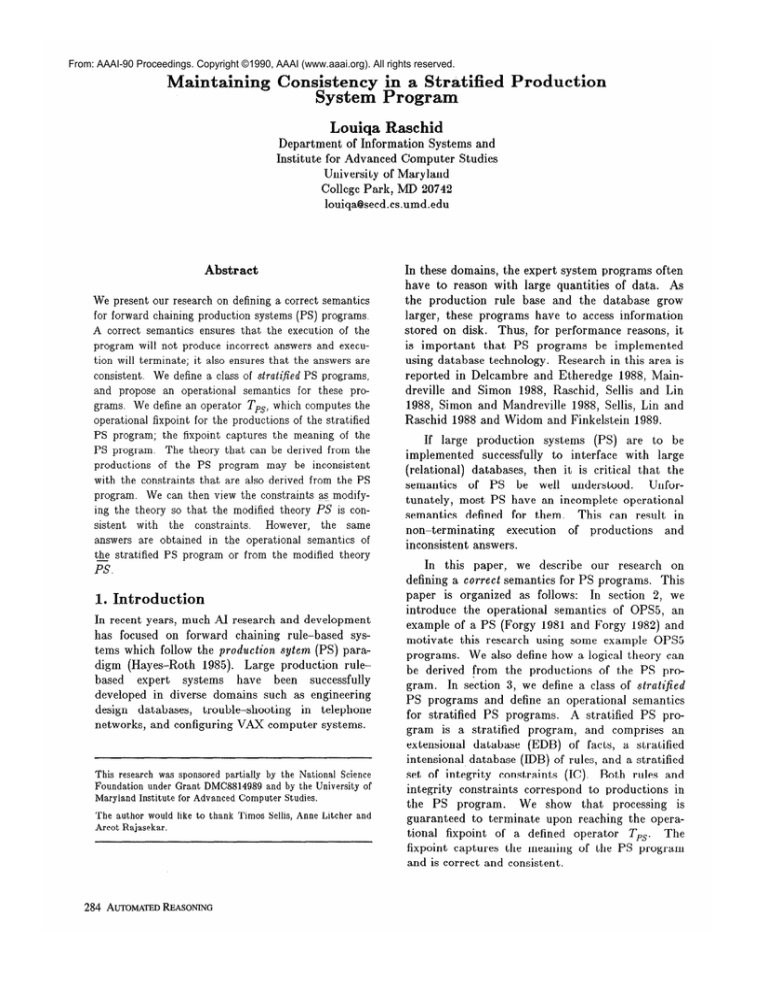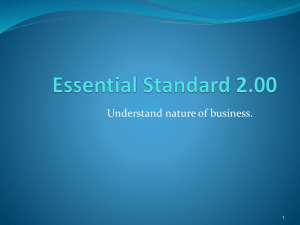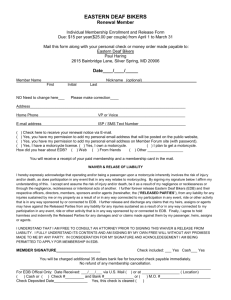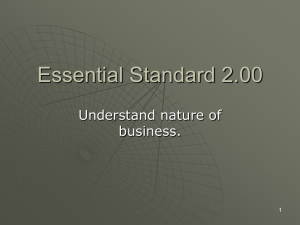
From: AAAI-90 Proceedings. Copyright ©1990, AAAI (www.aaai.org). All rights reserved.
Maintaining
Consistency
System
Louiqa
in a Stratified
Program
Production
Raschid
Department of Information Systems and
Institute for Advanced Computer Studies
University of Maryland
College Park, MD 20742
louiqa@secd.cs.umd.edu
Abstract
We present
our research
on defining
a correct
semantics
for forward chaining production
systems (PS) programs.
A correct semantics
ensures that the execution of the
program will not produce incorrect answers and execution will terminate;
it also ensures that the answers are
consistent.
We define a class of stratified
PS programs,
and propose an operational
semantics
for these programs. We define an operator TPs, which computes the
operational
fixpoint for the productions
of the stratified
PS program; the fixpoint captures the meaning of the
PS program.
The theory that can be derived from the
productions
of the PS program
may be inconsistent
with the constraints
that are also derived from the PS
We can then view the constraints
program.
-as modifying the theory so that the modified theory PS is conHowever,
the same
sistent
with
the constraints.
answers are
the stratified
E.
obtained
in the operational
semantics
of
PS program or from the modified theory
1. Introduction
In recent years, much AI research and development
has focused on forward chaining rule-based
syssytem (PS) paratems which follow the production
digm (Hayes-Roth
1985). Large production
rulehave
been
successfully
based
expert
systems
developed in diverse domains such as engineering
trouble-shooting
in telephone
design databases,
networks, and configuring VAX computer systems.
This research was sponsored partially
by the National Science
Foundation
under Grant DMC8814989
and by the University of
Maryland Institute for Advanced Computer Studies.
The author would like to thank
Arcot Rajasekar.
284
AUTOMATEDREASONING
Timos
Sellis, Anne Litcher
and
In these domains, the expert system programs often
have to reason with large quantities of data. As
the production
rule base and the database grow
larger, these programs have to access information
stored on disk. Thus, for performance
reasons, it
is important
that PS programs
be implemented
using database technology.
Research in this area is
reported in Delcambre and Etheredge 1988, Maindreville and Simon 1988, Raschid, Sellis and Lin
1988, Simon and Mandreville 1988, Sellis, Lin and
Raschid 1988 and Widom and Finkelstein 1989.
If large
implemented
production
systems (PS) are to be
successfully
to interface with large
(relational)
databases, then it is critical that the
Unforsemantics
of PS be well understood.
tunately, most PS have an incomplete operational
semantics
defined for them.
This can result in
non-terminating
execution
of productions
and
inconsistent answers.
In this paper, we describe our research on
defining a correct semantics for PS programs.
This
paper is organized
as follows:
In section 2, we
introduce the operational
semantics of OPS5, an
example of a PS (Forgy 1981 and Forgy 1982) and
motivate this research using some example OPS5
programs.
We also define how a logical theory can
be derived from the productions
of the PS proIn section 3, we define a class of stratified
gram.
PS programs and define an operational semantics
for stratified PS programs.
A stratified PS program is a stratified program,
and comprises an
extensional
database (EDB) of facts, a stratified
intensional database (IDB) of rules, and a stratified
set of integrity constraints
(IC).
Both rules and
integrity constraints correspond to productions
in
the PS program.
We show that processing
is
guaranteed to terminate upon reaching the operational fixpoint of a defined operator
TPs.
The
fixpoint captures the meaning of the PS program
and is correct and consistent.
The theory of the PS program, comprising the
EDB facts and the IDB rules that are derived from
may be inconsistent
with the
the productions,
integrity
constraints
(IC) that are also derived
from the productions.
We can view the IC as
modifying-the
theory so that the modified stratified
theory PS will be consistent with IC.
This is
described
in section
4.
We
also
show
the
equivalence between the answers obtained in the
operational fixpoint and the minimal model for the
theory E.
2. The OPS5
Production
System
In this section we introduce the operational
tics defined
for the OPS5
production
semansystem
language and highlight some of its problems.
We
chose the OPS5 production system language (Forgy
1981 and Forgy 1982) as an example.
Operational
Semantics
of OPS5
An OPS5 knowledge base comprises a set of productions
and an extensional
database (EDB) of
ground positive unit clauses which may be stored
in relations.
There will be one relation
ing to each predicate.
correspond-
the relations do not contain
to the negative literals.
of first order
interpretation
corresponding
The antecedent
of each production
is interpreted as a query against the EDB relations.
For
example,
for
each
of
the
positive
literals,
P(al, a2,. .am, x1, x2,. .xn), relation P is queried,
and a set of instantiated
tuples of P satisfying each
positive literal in the antecedent is retrieved.
For
each
of the negative
literals,
Q, the query
corresponding
to
the
first
order
formula,
), is
-I ( 3 Xl, 3, **xn Q(al, a27**7am,~17~2 **>Xn)
verified against the relation
Q.
Note that since the
corresponding
of the make action is to insert the
tuple into the R relation.
Similarly,
the remove action deletes the existing tuple from
This requires that the expression
the P relation.
that is referred to by the
P(a,, a2,.*,a,,x1, x z,..,x,)
remove action must occur as a positive
the antecedent of that production.
We
note
that
the
OPS5
language
literal
has
in
many
additional features that are not described here; we
have not considered the effect of such features in
our research.
semantics
of an OPS5 program
has been defined as follows: The initial state of the
PS corresponds to an initial EDB, corresponding
to
all the tuples of the EDB relations, and a set of
productions.
Processing
in a production
system
repeatedly cycles through the following sequence:
Match
For
each
production,
the
antecedent,
inter-
preted as above, is queried against the tuples of
the corresponding
relations.
Each production
whose antecedent is satisfied, together with its
instantiated
tuples is placed in a conflict
set.
v Xl, x2,+- x, P(al~ a2,-*am, xl7 x2,**xn)
or negative literals of the form:
v Xl, x2,- xn lQ(alr a2,--am, x 17 x2, *eXn)- P and
Q are (n+m)-ary
predicates c(lrresponding to the
constants
and
EDB
relations,
al, a2,...a,
are
e
that
all
variables
x2,..xn
are
variables.
Assum
x1j
- 11 11 1
--- TWLtJC-TCSLTZC
__- ._ - _ .--1.‘.1.3
:
--~~al-e
tea, i.e., any variance tnat occurs
in a literal must appear in a positive literal. The
advantages of this restriction have been discussed
in Sadri and Kowalski 1988 and correspond to the
safety of evaluating queries.
tuples
The
consequent
actions
are of the form:
or
(make R(a 1, a2,-,a,,x1,
xz7-,x,) )
(remove P(a 1, a2,.., a,,xi, x2 ,.., xn) ), where P and
R are relations.
Again, we assume that all variThe
ables xi, x2, . . . , x, are range restricted.
The operational
An OPS5 production consists of (1) the symbol
p, (2) the name
of the production,
(3) the
antecedent
or the left hand side (LHS), (4) the
symbol +, and (5) the consequent actions or the
right hand side (RHS), enclosed within parentheses.
The an tecedent is a coniunction
positive literals of the form:
range-restricted,
queries
variables
are
the
corresponding to the negative literals can always be
The
antecedent
of a production
is
verified.
satisfied
if the relations contain instantiated tuples
corresponding
to each of the positive literals and
Select
Select one satisfied production from the conflict
set. If there is no such production,
halt execution.
Act
For this selected production,
execute the make
or remove action, interpreted as above.
As a
result of the Act phase, the EDB relations are
updated.
Consequently,
the next Match phase
may produce a new conflict set.
There is no concept of a query that retrieves
information, in a PS program.
Processing will continue as long as productions
are executed and the
EDB relations are updated.
Processing terminates
when an operational fixpoint is reached, i.e., when
there are no longer any productions
that can
update
the EDB
relations.
This
operational
RASCHID
285
fixpoint (or the updated relations)
the meaning of the PS program.
Shortcomings
corresponds
to
A Corresponding
Logical
Theory
In order to understand
the shortcomings
operational
semantics,
and to define a
semantics,
we define how a logical theory
of the Operational
obtained
Semantics
from the productions
of the
correct
can be
in the PS program.
The operational
semantics for OPS5 are incompletely defined.
Consequently,
an initial EDB of
relations and a set of productions can produce different answers.
In some cases, an operational
fixpoint is never reached.
Definition
Every production that has a make action in its
consequent corresponds to a rule of an inten-
Example
h&P;lJy,
1
Consider a PS whose initial EDB has two tuples,
{Employee(Mike).
GoodWorker(Mike).),
and the
following set of productions:
(p p1 (Employee(X),
GoodWorker(
+
( make Manager(X) ) )
(p ps (Manager(X)) + ( make HasOffice
(p p, (Employee(X),
HasOffice(
+
( make PoorWorker
) )
(p p4 (Manager(X), PoorWorker(
-+
( remove Manager(X) ) )
) )
Given this initial EDB and corresponding set of
productions,
p,, p, and p, will execute in that
sequence
and
the
tuples
Manager(Mike),
HasOffice(Mike)
and PoorWorker(Mike)
will be
added to the corresponding
EDB relations.
Next,
p, executes and the tuple Manager(Mike)
will be
deleted from the Manager relation.
Subsequently,
p, and p, will execute, first inserting the tuple
Manager(Mike)
and then deleting this tuple from
the Manager relation. Processing of p, and p4 will
continue but an operational fixpoint is not reached.
Example
2
The initial
productions
(P P,
(p p,
(
(p ps
(
EDB = {Employee(Mike).)
and the
are as follows:
) )
(EmPloYeem
+ ( make GoodWorker
(Employee(X),
GoodWorker(
+
make Manager(X) ) )
(Employee(X),
1 GoodWorker(
+
make PoorWorker
) )
If productions
execute in the sequence pi followed by p,, then the final EDB will contain the
set of tuples (Employee(Mike).
GoodWorker(Mike).
Manager(Mike).).
If the execution sequence were
p, followed by p, and pz, then, the final EDB
would
include
the
tuples,
(Employee(Mike).
GoodWorker(Mike).
Manager(Mike).
PoorWorker(Mike).).
Thus, in this case there are
two fixpoints.
286 AUTOMATED
REASONING
sional database
For example,
P(x),
1
(IDB).
the following
-l Q(4)
+ (make
production:
R(x))
) CorresPonds
to
Q(x) + R(x).
Every production that has a remove action in
its consequent
corresponds
to an integrity
constraint (IC). G eneral forms of integrity constraints
and their treatment are discussed in Kowalski and
Sadri 1989; we delay a detailed discussion of constraints to a later section 4.
Definition
Every production that has (remove P(x) ) in
the consequent is a constraint.
The literal P(x)
is retracted literal to restore consistency.
Thus, the following
production:
~2 O=(x), 1 Q(x)) + (remove
P(x))
corresponds to the following IC:
(P
P(x),
1
)
Q(x) + .
P(x) is retracted
to maintain
database must not prove
Vx P(x) ~lQ(x).
consistency
and the
as
The meaning of treating some productions
integrity constraints will be discussed in section 4.
The following logical theory will be obtained,
corresponding to the productions of Example 1:
EDB = { Employee(Mike).
GoodWorker(Mike).
3
IDB = {Employee(X),
GoodWorker
+
Manager(X).
Manager(X) + HasOffice
.
Employee(X),
HasOffice
+PoorWorker(X).)
IC = {Manager(X),
PoorWorker
+ . 3
We can see that the logical theory of the PS is
inconsistent with the constraints.
Thus, there can
be no model for the theory which is also a model
for the constraints
(Lloyd 1987).
In the case of
Example
2, there is a negative
literal in the
antecedent of a rule. With Horn theories (including stratified theories), the modus ponens rule of
inference is insufficient to prove negative information. To do so one uses the closed world rule of
inference or the closed world assumption
(CWA).
The correct interpretation,
based on the CWA, is
that a tuple, <ai, aa,... a,> is not true if and only
if the IDB U EDB viewed as a logical theory cannot prove P(a,, a2,. . . a,).
In our example, it is
that
can
prove
clear
the
theory
GoodWorker(Mike),
and 1 GoodWorker(Mike)
canThus, the interpretation
of neganot be proved.
tive literals in the operational semantics of OPS5 is
incorrect.
3. Stratified
Production
negative literals in the antecedent of a rule; recall
that productions
in OPS5 have the same feature.
Our research draws upon existing research
in
databases
The Operational
(Apt, Blair and Walker
1988).
A stratified production
system program is viewed
as a stratified program, and comprises an extensional database (EDB) of facts, a stratified intensional database (IDB) of rules, and a stratified set
of integrity
constraints
(IC).
Both
rules and
integrity constraints correspond to productions
in
PS.
comprises
the following:
(1) an intensional database of rules (IDB), where
each rule corresponds to a production that has
a make action as its consequent,
(2) a set of integrity constraints (IC), where each
integrity constraint corresponds to a production
that has a remove action as its consequent,
and
(3) an initial extensional
database
of facts (EDBe).
In the operational semantics, there must exist a
partition so that PS is a stratified database.
Thus,
PS =
PS, u PS,
. . . u
PS,.
Each of the partitions PS, comprises a set of
rules IDBi, and a set of integrity constraints .TCd,
each of which may be possibly empty.
Partition
PS,
comprises
the initial
extensional
database
EDB,;
IDB, and IC, are null.
ditions
hold for the stratification:
(1) IDB = IDB, (J . . . u. ID&
(2) IC =
IC, 6
. . . l-J ICn
be contained
within
U IDB,.
j<i
a literal
is all productions
The definition
in which
of
the literal
occurs in the make action.
,
For every positive
literal
in IDB,, or in the body
straint in ICi, all other
where the literal
occurs
must be contained
within
in the body
of a rule
of an integrity conintegrity constraints
in the remove
action
U ICi.
j<i
every negative literal in a rule in IDB,, or
in an integrity constraint in lCi, the definition
(5) For
of that literal must be contained
within
U IDBi.
Semantics
The initial PS program
every positive literal in the body of a rule
in IDB,, or in the body of an integrity constraint in ICi, the definition of that literal must
(4
Systems
We identify a class of stratified PS programs, and
we define an operational semantics for these proStratification is an extension of Horn programs.
grams to more general Horn programs that allow
stratified
(3) For
The following
con-
j<S
every negative literal in a rule in IDBi, or
in an integrity constraint in ICi, all integrity
constraints
where the literal occurs
in the
remove action must be contained within
(6) For
U ICi.
jr
i
The Operator
Tps
Once such a partition has been obtained for the
stratified PS program, then, for each partition PS,,
we define an operator Tps as follows:
t
Definition
Ups is a Herbrand
universe for the stratified
PS
comprising predicates (make P), (remove P),
where P ranges over all propositional
variables
in the PS.
If we consider a PS program
tional variables are the set (A,
the set of predicates {(make
(make B), (remove B),(make
In the case of predicate
where the proposiB, C3, then Ups is
A), (remove
A),
C), (remove C)>.
variables,
we will use
relations to represent Ups, two for each predicate
symbol.
Thus, for predicate P, relation makeP
will contain all tuples P( .,.,. . .) which are added by
some action (make P( .,. ,. . .)) and relation removeP
will contain all tuples P( .,.,...) which are removed
by some action (remove P( .,.,... )).
Definition
For each proposition
P (or ground positive
literal P( .,.,...) ), in EDB,, we replace it with
(make
P), (or we add the tuple P( .,.,...)
to the
RASCHID
287
( make Manager(X)
relation makeP).
Definition
The interpretation of the predicates of Ups (for
the propositional
variable P), is defined as follows:
PI h-l=
P) I= P
A 1 (remove
PI
(2) (make P)
A (remove
(3) 1 (make P)
P) L
A 1 (remove
7 P
P) b
from a subset of Ups to Ups,
such that for any rule in IDBi
or any integrity
constraint in rCi, if there exists an interpretation of EDBi-, , as described above, such that
the literals in the antecedent of the corresponding production are true, then, the operator adds
to
the action in the head of the production
EDBi .
Each EDBi is computed
EDB,
= ED&
u
Tps, t w (EWJ
= ED4
u
TPS, t w (ED4)
EDB,
= EDB,-,
u
TPSa t
w (EW-1)
Obtaining
an Operational
Fixpoint
Processing
for each partition
Psi
for
should
Tps
terminate
when an operational fixpoint is reached, i.e., when
there are no longer any satisfied productions
that
Processing for PS terminates
can update EDBi.
when the operational
fixpoint for PS, is reached
and EDB,
is computed.
Theorem
Tps f
w
(EDBi-~)
is
a
fixpoint
for
PS,
=
IDLE U ICi.
We refer the reader to (Rasc89)
Example
3
Consider a PS whose initial EDB has two tuples,
(Employee(Mike).
GoodWorker(Mike).),
and the
following set of productions:
(p p1 (Employee(X),
GoodWorker(
+
( make Manager(X) ) )
(p p4 (Employee(X),
288 AUTOMATEDREASONING
HasOffice(
-+
Consistency
Constraints
) )
with
We now try to understand the meaning of maintaining consistency with respect to integrity constraints in a stratified PS program.
Informally,
a
database must satisfy its integrity constraints as it
changes over time. Usually, an update to the database (more precisely an update to facts in the
EDB) may cause the violation of an integrity constraint; such updates are rejected or modified.
Sometimes, the database itself, i.e., the facts and
the rules may be inconsistent with the constraints
A(t), Conj+.
where Conj is a conjunction of positive or negative
literals (and may be empty). The denial, or the
body of the constraint, should not be true in the
database.
The atom A is the retractable
atom that
restores consistency, if the constraint is violated.
Thus, if we consider the theory CC. C + A3 and
the constraint A, 1B +, where the retractable atom
is A, then, the theory is inconsistent with the contheory
However,
the
transformed
straint.
(C. C, B +A3 is consistent
for the proof.
(p p2 (Employee(X))
+ ( make HasOffice
(p p3 (PoorWorker(
HasOffice(
+
( remove HasOffice
) )
4. Maintaining
Integrity
and must be modified, to maintain consistency.
In
Kowalski
and Sadri 1989, such a method
is
presented for transforming a theory which is inconsistent with respect to a set of integrity constraints
into a transformed theory which is consistent with
the constraints.
The transformation
is syntactic.
Although the transformation
works for more general constraints, we restrict the discussion to denial
constraints of the form
as follows:
‘EDB,
The stratification
conditions will place productions p, in a higher stratum, say PS,, while the
other three productions
are placed in PS,.
The
EDB,
is
as
follows:
operational
fixpoint
makePoorWorker(Mike).
CmakeEmployee(Mike).
removeHasOffice(Mike).)
makeHasOffice(Mike).
EDB,
is interpreted
to prove I HasOffice(Mike)
and Manager(Mike)
will not be an answer.
1 P
(4) 1 (make P) A (remove P) is not allowed in
the operational
semantics
and represents an
inconsistency.
Definition
T ps is a mapping
) )
with the constraint.
If we apply a similar transformation
to the
theory obtained from the productions
of Example
3, we obtain the following consistent theory:
EDB = (Employee(Mike).
GoodWorker(Mike).
3
IDB=(Employee(X),
GoodWorker(X)+Manager(X).
Employee(X)
lPoorWorker(X)+
HasOffice(
Employee(X),
HasOffice
+ Manager(X). 3
see that
this theory
will
not
prove
We
Manager(Mike),
just as in the operational
semantics.
In general, we can prove that if the PS
program
is stratifiable
as defined,
then the follow-
ing hold: (1) the logical theory derived from the
modified to be consistent
stratified PS program,
with the constraints (also derived from the program), is a stratified theory.
(2) the operational
fixpoint of the stratified PS program is identical to
the model for the modified consistent theory that is
derived from the program.
PS programs
and
an opera-
tional semantics for these programs
have been
defined. The theory derived from the productions
is modified so that it forms a consistent theory, I%,
with the integrity constraints that are also derived
from the productions.
The operational fixpoint of
PS is identical to the model for I%.
A formal
presentation of this research is in Raschid 1989.
Future research includes extending the semantics of
PS programs to include PS programs that exhibit
non-deterministic
behaviour when executing productions.
6. References
Apt, K-R., Blair,
Towards a Theory
(Minker 1988).
H.A. and Walker,
A. 1988.
of Declarative Knowledge.
In
Delcambre, L.M.L. and Etheredge,
J.N. 1988. A
Self-Controlling
Interpreter for the Relational Production Language. In Proceedings of the ACM Sigmod International
of Data.
Conference
J.,
ed.
1988.
Foundations
of
Deductive
Morgan
Databases
and Logic Programming.
mann Publishers, Inc.
Kauf-
Raschid, L. 1989. Defining a Semantics for Production Systems based on Stratified Databases and
Technical
Report
89-103,
Integrity
Constraints,
University
of Maryland.
T. and Lin,
Raschid,
L., Sellis,
Exploiting
Concurrency
in a DBMS
5. Summary
A class of stratified
Minker.
C-C.
1988.
Implementa-
tion for Production Systems. In Proceedings of the
International
Symposium on Databases in Parallel
and Distributed Systems.
Sadri,
Proving
(Minker
F.
and
Kowalski,
Approach
1988).
Sellis, T., Lin, C-C.
to
R.
1988.
Database
and Raschid,
A
Theorem-
Integrity.
L. 1988.
In
Imple-
menting Large Production
Systems in a DBMS
Environment:
Concepts
and
Algorithms.
In
Proceedings
of the ACM
Sigmod
International
Conference on the Management of Data.
Simon, E. and Maindreville,
C. de, 1988. Deciding
Whether a Production
Rule is Relational Computable. In IProceedings of the International
Conference on Database Theory.
Widom,
J. and Finkelstein, S.J. 1989. A Syntax
and Semantics for Set-Oriented
Production
Rules
in Relational
Database
Systems,
IBM Research
Report, IBM Almaden Research Center.
on the Management
Forgy, C.L. 1981. OPS5 User’s Manual, Technical
Report CMU-CS-81-135,
Carnegie-Mellon
University.
Forgy,
C.L. 1982.
Rete: A Fast Algorithm
Many Pattern/Many
Object Pattern
lem. Artificial
Intelligence
(19).
Hayes-Roth,
munications
Match
F. 1985. Rule Based Systems.
of the ACM(28) 9.
for the
ProbCom-
Kowalski,
R. and Sadri, F. 1989. Knowledge
Representation
without
Integrity
Constraints.
Technical Report, Imperial College, London, England.
Lloyd, J.W. 1987. Foundations
ming, Second, Extended Edition.
of Logic ProgramSpringer Verlag.
Maindreville,
C. de and Simon, E. 1988. A Production Rule Based Approach
to Deductive Databases. In Proceedings of the Fourth International
Conference on Data Engineering.
RASCHID
289



